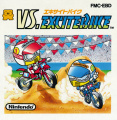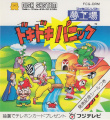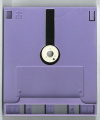Difference between revisions of "Famicom Disk System"
(→Media) |
|||
| (17 intermediate revisions by the same user not shown) | |||
| Line 1: | Line 1: | ||
[[Image:Famicom Disk System.jpg|thumb|256x256px|Famicom Disk System loaded with a [[Famicom]].]] | [[Image:Famicom Disk System.jpg|thumb|256x256px|Famicom Disk System loaded with a [[Famicom]].]] | ||
| − | The '''Family Computer Disk System (ファミリーコンピュータ ディスクシステム [Famiri Konpyuta Disuku Shisutemu]''', known commonly as the '''Famicom Disk System''' is a disk drive attachment to the [[Famicom]] created by [[Nintendo]] and released only in Japan on 1986-02-21. To use the Famicom Disk System (FDS), the disk drive is placed below the Famicom, and a communication unit is placed into the cartridge slot of the Famicom. Disks are placed into the drive and both the Famicom and FDS are turned on. Upon booting, the game is loaded from the disk, and, when it finishes, you can start playing the game. Famicom disks are double sided, but the reader is not, so larger games require the user to flip the disk over as needed. Because the disks are re-writable, FDS games may save the player's progress directly to the disk to be loaded later. Also, the FDS included a new audio channel | + | The '''Family Computer Disk System (ファミリーコンピュータ ディスクシステム [Famiri Konpyuta Disuku Shisutemu]''', known commonly as the '''Famicom Disk System''' is a disk drive attachment to the [[Famicom]] created by [[Nintendo]] and released only in Japan on 1986-02-21. To use the Famicom Disk System (FDS), the disk drive is placed below the Famicom, and a communication unit is placed into the cartridge slot of the Famicom. Disks are placed into the drive and both the Famicom and FDS are turned on. Upon booting, the game is loaded from the disk, and, when it finishes, you can start playing the game. Famicom disks are double sided, but the reader is not, so larger games require the user to flip the disk over as needed, and a few games even spanned multiple disks. Because the disks are re-writable, FDS games may save the player's progress directly to the disk to be loaded later. Also, the FDS included a new audio channel which added a programmable waveform to the existing APU. Though this channel is primitive by today's standards, it was very impressive at the time. |
| − | To help sell FDS games, Nintendo sold Famicom Disk System vending kiosks called "Disk Writers" to various game shops around Japan. A user could insert a blank disk, pay a fee, and have new games written to their disk. However, because there wasn't anything too complex about the disk design, third-party manufacturers began selling off-brand disks and copiers which made piracy pretty easy. The FDS also was expensive and had a tendency to break down, | + | To help sell FDS games, Nintendo sold Famicom Disk System vending kiosks called "Disk Writers" to various game shops around Japan. A user could insert a blank disk, pay a fee, and have new games written to their disk. However, because there wasn't anything too complex about the disk design, third-party manufacturers began selling off-brand disks and copiers which made piracy pretty easy. The FDS also was expensive and had a tendency to break down, which prevented it from selling well, so Nintendo didn't try to market it outside of Japan. Those games that did sell well on the FDS were remade to run on the [[Nintendo Entertainment System|NES]] with passwords, or, for later games, battery backups to save progress. |
| + | ==Personal== | ||
Since the FDS was only released in Japan, I never played it when it was popular, and still have never played an actual console. However, with the advent of emulation, I have since played many of the games released on the platform. | Since the FDS was only released in Japan, I never played it when it was popular, and still have never played an actual console. However, with the advent of emulation, I have since played many of the games released on the platform. | ||
| − | |||
I do not own a Famicom Disk System and have never played a real one. | I do not own a Famicom Disk System and have never played a real one. | ||
| Line 13: | Line 13: | ||
: ''See all [[:Category:Famicom Disk System Games|Famicom Disk System Games]].'' | : ''See all [[:Category:Famicom Disk System Games|Famicom Disk System Games]].'' | ||
| + | ===Initial Games=== | ||
| + | The Famicom Disk System did not ship with a pack-in game. | ||
| + | |||
| + | The following games were available at the console's launch: ''[[Baseball]]'', ''[[Golf]]'', ''[[The Legend of Zelda]]'', ''[[Mahjong]]'', ''[[Soccer]]'', ''[[Super Mario Bros.]]'', ''[[Tennis]]''. Of the launch titles, only ''The Legend of Zelda'' was new to the platform, all the others had been previously released on the Famicom. | ||
| + | |||
| + | ===Personal=== | ||
These are the FDS games that are important to me: | These are the FDS games that are important to me: | ||
| − | + | ||
| − | + | <gallery> | |
| − | + | Kid Icarus - Angel Land Story - FDS - Japan.jpg|''[[Kid Icarus: Angel Land Story]]'' | |
| − | + | Legend of Zelda, The - FDS - Japan.png|''[[The Legend of Zelda]]'' | |
| − | + | Metroid - FDS - Japan.jpg|''[[Metroid]]'' | |
| − | + | Section-Z - FDS - Japan.jpg|''[[Section-Z (NES)|Section-Z]]'' | |
| + | Vs. Excitebike - FDS - Japan.jpg|''[[Excitebike|Vs. Excitebike]]'' | ||
| + | Yume Kojo - Doki Doki Panic - FDS - Japan.jpg|''[[Super Mario Bros. 2|Yume Kojo: Doki Doki Panic]]'' | ||
| + | Legend of Zelda 2, The - Adventure of Link, The - FDS - Japan - Disk Sleeve.jpg|''[[Zelda II: The Adventure of Link]]'' | ||
| + | </gallery> | ||
==Review== | ==Review== | ||
===Good=== | ===Good=== | ||
| − | * Having a way to save and load was | + | * The disks were able to store 112 KB of data (56 KB per side) which was over twice the size and less than a quarter of the cost of ROM cartridges at the time. This allowed developers to make games with more complexity and still save money. |
| + | * Having a way to save and load to the disk was vastly superior than password systems. | ||
* Being able to sell games through an automatic vending kiosk was way ahead of its time. | * Being able to sell games through an automatic vending kiosk was way ahead of its time. | ||
* The additional audio channel was a nice addition, unfortunately, few developers took advantage of it. | * The additional audio channel was a nice addition, unfortunately, few developers took advantage of it. | ||
===Bad=== | ===Bad=== | ||
| − | * Disk reading and writing was pretty slow | + | * Disk reading and writing was pretty slow and most games required turning the disk over to load from both sides. Both are annoying if you're used to the instant speed of a cartridge. |
| − | |||
* Like all magnetic disks, the Famicom disks eventually had bad sectors causing the loss of a game. | * Like all magnetic disks, the Famicom disks eventually had bad sectors causing the loss of a game. | ||
| − | * Most of the games made for the platform didn't take advantage of the new hardware. | + | * In less than a year, two of the key features of the FDS (112 KB memory and the ability to save games) were replicated on the Famicom. ROM prices dropped and comparable sizes became available, and battery backups allowed for saved games. Cartridges were still more expensive, but individually, they were still a lot cheaper than an whole new system. |
| − | * The FDS required its own power supply. | + | * Although Nintendo did sell over 4 million units, it was a far cry from the 62 million of the Famicom/NES. Rampant piracy and hardware failures no doubt contributed to the platform not doing nearly as well. |
| + | * Most of the games made for the platform didn't take advantage of the new hardware, and many of the releases were already available for the Famicom, or would be released for the Famicom within a few years of their FDS release. | ||
| + | * The FDS required its own power supply which was clunky just like the Famicom. This often required a multi-tap outlet. Although, it could optionally be run off six C-cell batteries. | ||
===Ugly=== | ===Ugly=== | ||
| Line 44: | Line 56: | ||
Famicom Disk System - Package.jpg|The unboxed FDS. | Famicom Disk System - Package.jpg|The unboxed FDS. | ||
Famicom Disk System - Games.jpg|A collection of game cases and a disk. | Famicom Disk System - Games.jpg|A collection of game cases and a disk. | ||
| + | Famicom Disk System - Blank Floppy.jpg|A blank FDS disk. | ||
| + | Famicom Disk System - Third-Party Floppy.jpg|A bootleg FDS disk. | ||
</gallery> | </gallery> | ||
| − | === | + | ===Documentation=== |
| + | <gallery> | ||
| + | This Is Family Computer!! Disk System - Comic.pdf|''This Is Family Computer!! Disk System''. | ||
| + | This Is Family Computer!! Disk System - Comic - Translated.pdf|''This Is Family Computer!! Disk System'' (translated). | ||
| + | </gallery> | ||
| + | |||
| + | ===Logos=== | ||
<gallery> | <gallery> | ||
Famicom Disk System - Logo.png|Logos. | Famicom Disk System - Logo.png|Logos. | ||
</gallery> | </gallery> | ||
| + | |||
| + | ===Videos=== | ||
| + | {{YouTube|_uMzRAl8-jE|Review - NES Works.}} | ||
==Links== | ==Links== | ||
| − | + | {{Link|Wikipedia|https://en.wikipedia.org/wiki/Family_Computer_Disk_System}} | |
| − | + | {{Link|MobyGames|http://www.mobygames.com/attribute/sheet/attributeId,2001}} | |
| + | {{Link|VGMPF|2=http://www.vgmpf.com/Wiki/index.php?title=Famicom_Disk_System}} | ||
[[Category: Video Game Platforms]] | [[Category: Video Game Platforms]] | ||
Latest revision as of 12:15, 7 November 2023

The Family Computer Disk System (ファミリーコンピュータ ディスクシステム [Famiri Konpyuta Disuku Shisutemu], known commonly as the Famicom Disk System is a disk drive attachment to the Famicom created by Nintendo and released only in Japan on 1986-02-21. To use the Famicom Disk System (FDS), the disk drive is placed below the Famicom, and a communication unit is placed into the cartridge slot of the Famicom. Disks are placed into the drive and both the Famicom and FDS are turned on. Upon booting, the game is loaded from the disk, and, when it finishes, you can start playing the game. Famicom disks are double sided, but the reader is not, so larger games require the user to flip the disk over as needed, and a few games even spanned multiple disks. Because the disks are re-writable, FDS games may save the player's progress directly to the disk to be loaded later. Also, the FDS included a new audio channel which added a programmable waveform to the existing APU. Though this channel is primitive by today's standards, it was very impressive at the time.
To help sell FDS games, Nintendo sold Famicom Disk System vending kiosks called "Disk Writers" to various game shops around Japan. A user could insert a blank disk, pay a fee, and have new games written to their disk. However, because there wasn't anything too complex about the disk design, third-party manufacturers began selling off-brand disks and copiers which made piracy pretty easy. The FDS also was expensive and had a tendency to break down, which prevented it from selling well, so Nintendo didn't try to market it outside of Japan. Those games that did sell well on the FDS were remade to run on the NES with passwords, or, for later games, battery backups to save progress.
Contents
Personal
Since the FDS was only released in Japan, I never played it when it was popular, and still have never played an actual console. However, with the advent of emulation, I have since played many of the games released on the platform.
I do not own a Famicom Disk System and have never played a real one.
Games
- See all Famicom Disk System Games.
Initial Games
The Famicom Disk System did not ship with a pack-in game.
The following games were available at the console's launch: Baseball, Golf, The Legend of Zelda, Mahjong, Soccer, Super Mario Bros., Tennis. Of the launch titles, only The Legend of Zelda was new to the platform, all the others had been previously released on the Famicom.
Personal
These are the FDS games that are important to me:
Review
Good
- The disks were able to store 112 KB of data (56 KB per side) which was over twice the size and less than a quarter of the cost of ROM cartridges at the time. This allowed developers to make games with more complexity and still save money.
- Having a way to save and load to the disk was vastly superior than password systems.
- Being able to sell games through an automatic vending kiosk was way ahead of its time.
- The additional audio channel was a nice addition, unfortunately, few developers took advantage of it.
Bad
- Disk reading and writing was pretty slow and most games required turning the disk over to load from both sides. Both are annoying if you're used to the instant speed of a cartridge.
- Like all magnetic disks, the Famicom disks eventually had bad sectors causing the loss of a game.
- In less than a year, two of the key features of the FDS (112 KB memory and the ability to save games) were replicated on the Famicom. ROM prices dropped and comparable sizes became available, and battery backups allowed for saved games. Cartridges were still more expensive, but individually, they were still a lot cheaper than an whole new system.
- Although Nintendo did sell over 4 million units, it was a far cry from the 62 million of the Famicom/NES. Rampant piracy and hardware failures no doubt contributed to the platform not doing nearly as well.
- Most of the games made for the platform didn't take advantage of the new hardware, and many of the releases were already available for the Famicom, or would be released for the Famicom within a few years of their FDS release.
- The FDS required its own power supply which was clunky just like the Famicom. This often required a multi-tap outlet. Although, it could optionally be run off six C-cell batteries.
Ugly
- The rubber band that allowed the motor to spin the disk was made out of poor material and usually broke far earlier than it should.
Media
Hardware
The FDS attached to a Famicom.















